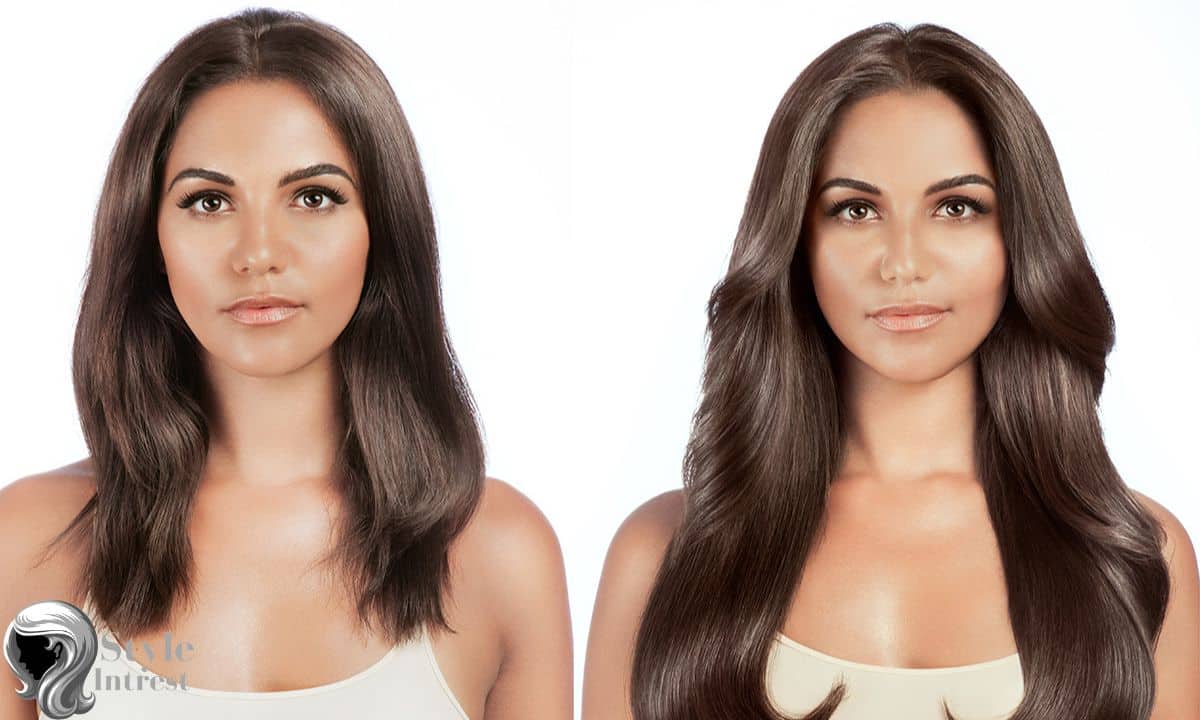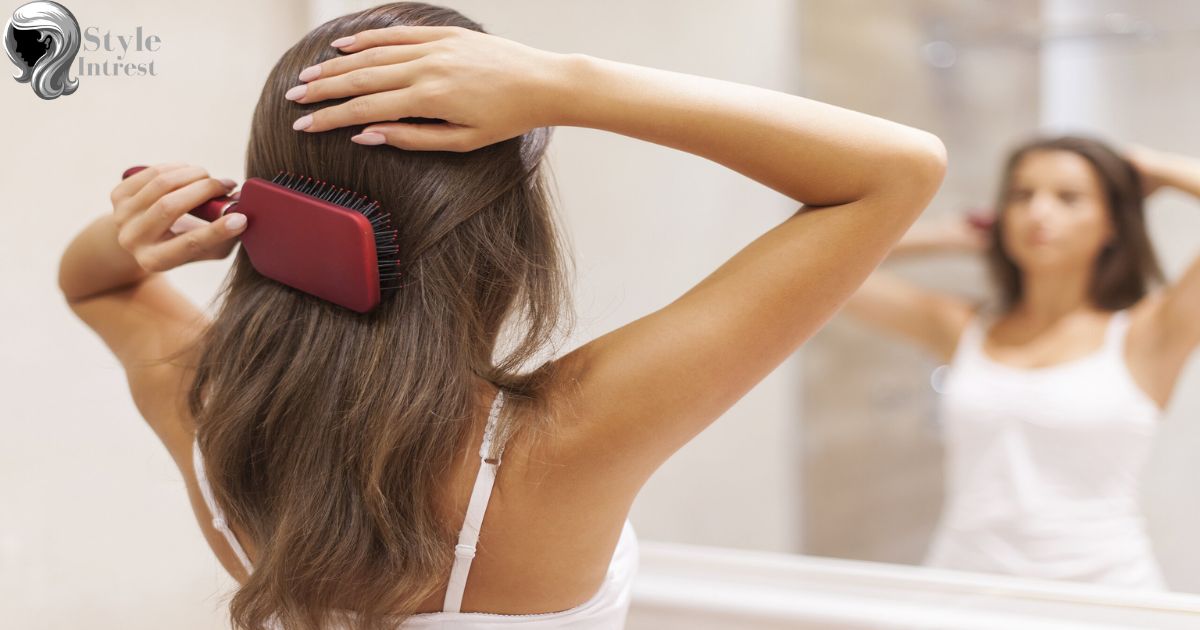Enhance your thin locks with the transformative power of clip-in extensions. Unlock the secret to achieving natural-looking volume and length with our comprehensive guide. From assessing your hair type to selecting the right extensions, we leave no strand unturned. Master the art of seamless blending and discover foolproof techniques to conceal and secure your clip-ins. Join a community of hair enthusiasts as we share the keys to maintaining and caring for your extensions. Unleash your hair’s full potential and belong to a world of endless possibilities.
Key Takeaways
- Consider the density, texture, and length of your natural hair and the extensions
- Opt for lightweight extensions specifically made for thin hair
- Look for high-quality, natural-looking materials like human hair
- Proper sectioning and secure clipping methods are crucial for a seamless blend
Assessing Your Hair Type and Extensions
Assessing your hair type and extensions is crucial for achieving a seamless and natural-looking blend. When it comes to clip-in extensions for thin hair, it is essential to consider the density, texture, and length of both your natural hair and the extensions. Thin hair often lacks volume, so opting for extensions that are lightweight and made specifically for thin hair is essential. Look for extensions that are made from high-quality, natural-looking materials like human hair, as they will blend more seamlessly with your own hair.
Additionally, consider the length and texture of the extensions to ensure they match your natural hair. By assessing these factors, you can ensure that your extensions will blend flawlessly with your own hair, creating a natural and harmonious look. Now, let’s move on to preparing your natural hair for extensions.
Preparing Your Natural Hair for Extensions
Before applying extensions, it is crucial to prepare your natural hair properly. Start by washing and conditioning your hair to ensure it is clean and free from any product buildup. Next, detangle your hair gently using a wide-tooth comb or your fingers to minimize breakage. Lastly, protect your hair by applying a heat protectant and using products specifically designed for extensions to maintain their longevity and prevent damage.
Wash and Condition
I recommend using a sulfate-free shampoo and a nourishing conditioner to properly cleanse and condition your natural hair before applying the clip-in extensions. This will ensure that your hair is clean, moisturized, and ready for styling. Here are five important points to consider when washing and conditioning your hair for clip-in extensions:
- Choose a sulfate-free shampoo: Sulfates can strip your hair of its natural oils, leaving it dry and brittle. Opt for a sulfate-free shampoo to keep your hair healthy and hydrated.
- Use a nourishing conditioner: Look for a conditioner that is specifically formulated to hydrate and strengthen your hair. This will help to prevent damage and breakage when applying and removing the clip-in extensions.
- Focus on the roots and ends: When washing your hair, pay extra attention to the roots and ends, as these areas tend to be the most prone to dryness and damage.
- Rinse thoroughly: Make sure to rinse out all of the shampoo and conditioner from your hair to avoid product buildup, which can weigh down your hair and make it difficult to style.
- Pat dry gently: After washing, avoid rubbing your hair with a towel. Instead, gently pat it dry to prevent unnecessary breakage.
Detangle and Protect
To ensure optimal results when putting in clip-in extensions for thin hair, detangle and protect your natural hair by using a wide-tooth comb and a heat protectant spray. Detangling your hair before applying extensions is crucial, as it helps prevent any knots or tangles that may cause damage when removing the extensions later. Start by gently combing through your hair from ends to roots, using a wide-tooth comb to minimize breakage. Once your hair is detangled, it’s essential to protect it from heat damage.
Apply a heat protectant spray evenly throughout your hair, focusing on the ends where the extensions will be clipped in. This will create a barrier between your hair and any heat styling tools, ensuring that your natural hair remains healthy and undamaged. By following these steps, you can achieve flawless results when adding clip-in extensions to your thin hair.
Choose Proper Products
Using high-quality hair products and gentle cleansers is crucial when preparing your natural hair for clip-in extensions. Proper product selection ensures that your natural hair remains healthy and undamaged while seamlessly blending with the extensions. Here are five key factors to consider when choosing hair products for clip-in extensions:
- Sulfate-free shampoos: These gentle cleansers prevent stripping natural oils from your hair, keeping it hydrated and minimizing frizz.
- Moisturizing conditioners: Look for products with nourishing ingredients like argan oil or shea butter to provide deep hydration and prevent dryness.
- Leave-in conditioners: These products help detangle your hair and provide additional moisture throughout the day.
- Heat protectant sprays: Essential for protecting your natural hair and the extensions from damage caused by heat styling tools.
- Lightweight serums or oils: These products add shine and smoothness to your hair without weighing it down.
Choosing the Right Clip-In Extensions for Thin Hair
Selecting appropriate clip-in extensions for thin hair requires considering factors such as thickness, weight, and texture. Thin hair can present challenges when it comes to finding extensions that blend seamlessly and provide the desired volume and length. It is crucial to choose extensions that match the thickness of your natural hair to avoid a noticeable difference. Opt for lightweight clip-in extensions that won’t weigh down your hair and cause further damage.
Additionally, consider the texture of your natural hair and find extensions that closely resemble it for a more natural look. Researching different brands and reading reviews can help you find high-quality extensions that are specifically designed for thin hair. By taking these factors into account, you can select the right clip-in extensions that will enhance your thin hair and provide the desired result.
Sectioning and Clipping in the Extensions
In order to achieve a natural and seamless blend with clip-in extensions, proper sectioning is crucial. By dividing the hair into smaller sections, it becomes easier to clip in the extensions strategically and ensure they are securely in place. Additionally, a secure clipping method, such as using small, discreet clips, helps to prevent the extensions from slipping or falling out. These techniques are particularly important for those with thin hair, as they allow for a more customized and comfortable application.
Proper Sectioning Technique
Achieving a seamless blend with clip-in extensions for thin hair requires mastering the proper sectioning technique. By following these steps, you can ensure that your extensions blend seamlessly with your natural hair, giving you a fuller and more voluminous look:
- Start by sectioning off the top layer of your hair, clipping it away to expose the bottom layer.
- Take a small section of hair from the bottom layer and tease it gently at the roots to create texture and volume.
- Clip the extension onto the teased section, making sure to position it close to the roots for a natural look.
- Repeat this process, working your way up the back of your head and then moving to the sides, until all the extensions are in place.
- Finally, release the top layer of your hair and blend it with the extensions using a comb or your fingers.
Secure Clipping Method
By implementing a secure clipping method, the extensions can be seamlessly integrated into the hair, ensuring a natural and long-lasting hold. This method involves carefully sectioning the hair and using sturdy clips to securely attach the extensions. The key to a secure clipping method lies in the placement of the clips. It is important to position the clips close to the root of the hair, ensuring a snug fit and preventing the extensions from slipping or pulling on the hair.
Additionally, the use of high-quality clips with a strong grip is essential to maintain the hold throughout the day. By following this secure clipping method, individuals with thin hair can confidently wear clip-in extensions without worrying about them falling out or appearing unnatural. Now, let’s explore how clip-in extensions can be compatible with thin hair.
Thin Hair Compatibility
To ensure thin hair compatibility, carefully section the hair and securely clip in the extensions, allowing for a seamless integration and natural appearance. When it comes to clip-in extensions for thin hair, attention to detail is crucial. Here are five key points to consider:
- Choose extensions specifically designed for thin hair to ensure a lightweight and discreet look.
- Opt for extensions made from high-quality, 100% human hair for a natural blend with your own hair.
- Use a teasing comb or texturizing spray on the roots before clipping in the extensions to add volume and grip.
- Place the extensions strategically, focusing on areas where thinning or lack of volume is most noticeable.
- Blend the extensions with your natural hair by gently backcombing and smoothing the top layers, creating a seamless transition.
Blending and Styling the Extensions With Your Natural Hair
One important aspect to consider when blending and styling clip-in extensions with your natural hair is ensuring that they seamlessly integrate to create a cohesive and natural look. This is especially crucial for those with thin hair, as the extensions need to add volume and thickness without looking obvious or unnatural. To achieve this, start by selecting clip-in extensions that match the color and texture of your natural hair. Next, tease the roots of your hair to create a bit of texture and grip for the extensions to hold onto.
Then, place the extensions strategically throughout your hair, focusing on areas that need extra volume. Finally, gently comb and blend your natural hair with the extensions, using a soft-bristle brush or your fingers, and style as desired. By following these steps, you can achieve a seamless blend between your natural hair and clip-in extensions, creating a natural and voluminous look that is perfect for thin hair.
Securing and Concealing the Clip-Ins for a Natural Look
We can secure and conceal the clip-ins for a natural look by using bobby pins and hairspray. When it comes to clip-in extensions, proper application is key to achieving a seamless blend with your natural hair. To help you achieve a flawless finish, here are five tips to secure and conceal your clip-ins effectively:
- Start by sectioning your hair: Divide your hair into sections to ensure even distribution of the clip-ins and to prevent any bulkiness.
- Backcomb your roots: Teasing the roots of your hair will provide a better grip for the clips and help blend the extensions more seamlessly.
- Use bobby pins strategically: Secure the clip-ins by sliding bobby pins through the wefts and into your natural hair, ensuring a secure hold.
- Apply hairspray: Spraying a light mist of hairspray over the clip-ins will help them blend into your natural hair and stay in place.
- Style your hair: Once the clip-ins are securely attached, style your hair as desired to further enhance the natural look.
Maintaining and Caring for Clip-In Extensions in Thin Hair
Proper maintenance and care of clip-in extensions in thin hair is crucial in ensuring their longevity and preserving their natural appearance. Thin hair can be more delicate and prone to damage, so it is important to handle clip-in extensions with care. To maintain clip-in extensions in thin hair, it is recommended to gently detangle them using a wide-tooth comb or a special extension brush. Washing the extensions regularly with a sulfate-free shampoo and conditioner is necessary to keep them clean and free from product buildup.
Deep conditioning treatments can help restore moisture and keep the extensions soft and manageable. It is also important to store the extensions properly, preferably in a satin or silk bag, to prevent tangling and damage. By following these maintenance tips, clip-in extensions in thin hair can maintain their natural appearance and last longer.
FAQ’s
Can Clip-In Extensions Be Used on Thick Hair as Well?
Yes, clip-in extensions can be used on thick hair as well. They provide a quick and easy way to add length and volume to any hair type. Simply follow the same steps for putting them in, adjusting for the thickness of your hair.
How Long Do Clip-In Extensions Usually Last?
Clip-in extensions typically last between 6 to 12 months, depending on various factors such as the quality of the extensions, how well they are cared for, and how often they are worn.
Can Clip-In Extensions Cause Damage to Thin Hair?
Clip-in extensions can potentially cause damage to thin hair due to the weight and tension they add. It is important to choose high-quality extensions, properly distribute them, and avoid excessive pulling or tugging to minimize any potential harm.
Can Clip-In Extensions Be Styled Using Heat Tools?
Clip-in extensions can be styled using heat tools, but caution must be exercised to prevent damage to both the extensions and the natural hair. It is crucial to use heat protectant products and avoid excessive heat to maintain the integrity of the extensions.
Can Clip-In Extensions Be Washed and How Often Should They Be Washed?
Clip-in extensions can be washed to maintain their cleanliness and longevity. It is recommended to wash them every 6-8 wears or when they become visibly dirty. Follow the manufacturer’s instructions for best results.
Conclusion
In conclusion, by following the steps outlined in this article, individuals with thin hair can successfully put in clip-in extensions to achieve a natural-looking and voluminous hairstyle. By carefully assessing their hair type, preparing their natural hair, choosing the right extensions, sectioning and clipping them in, blending and styling them with their natural hair, and securing and concealing them properly, individuals can enjoy the benefits of clip-in extensions while maintaining and caring for them effectively.










